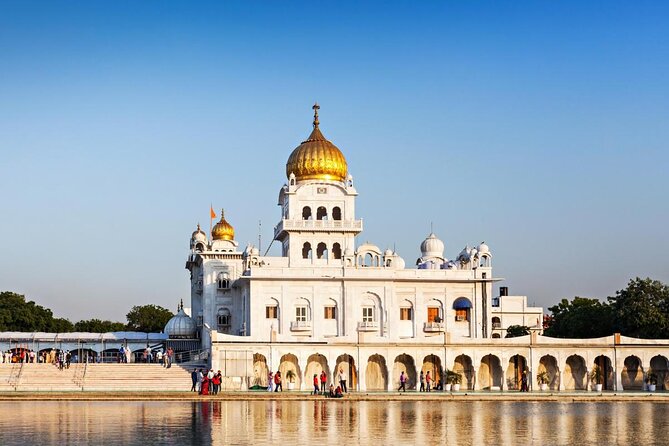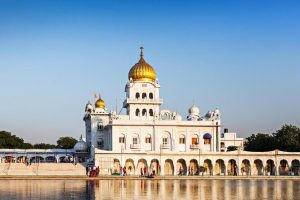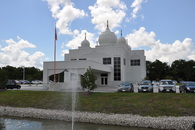
Gurdwara Bangla Sahib New Delhi
New Delhi, IndiaGurdwara Bangla Sahib New Delhi: A Spiritual Oasis in the Heart of the Capital
Gurdwara Bangla Sahib, located in the heart of New Delhi, is one of the most prominent Sikh gurdwaras in India. With its historical significance, architectural grandeur, and commitment to selfless service, Gurdwara Bangla Sahib stands as a revered spiritual and cultural landmark in the bustling capital city.
1. Historical Background: Gurdwara Bangla Sahib has a rich history that traces back to the 17th century. It is named after the haveli (mansion) owned by Raja Jai Singh, a Mughal noble. The eighth Sikh Guru, Guru Har Krishan Sahib Ji, visited this place during his stay in Delhi and blessed the site. Since then, it has become a sacred pilgrimage site for Sikhs and people of other faiths.
2. Architectural Marvel: The gurdwara complex of Bangla Sahib is known for its stunning architecture and serene ambiance. Its iconic golden dome and white marble structure reflect the traditional Sikh architectural style. The central prayer hall, known as the Diwan Hall, is adorned with intricate artwork, and the sanctum sanctorum houses the Guru Granth Sahib, the holy scripture of Sikhism.
3. Sarovar and Healing Powers: Gurdwara Bangla Sahib features a large sacred pool, known as the Sarovar, where devotees can take a dip to seek spiritual purification and solace. The water of the Sarovar is believed to possess healing properties, and people from various backgrounds come to bathe in it with the hope of finding relief from physical ailments and spiritual distress.
4. Langar and Community Service: One of the defining features of Gurdwara Bangla Sahib is its langar, which is one of the largest community kitchens in India. Volunteers tirelessly prepare and serve free meals to all visitors, irrespective of their caste, creed, or social status. The langar exemplifies the Sikh principle of equality and hospitality, fostering a sense of unity and compassion among all who partake in the communal meal.
5. Festivals and Celebrations: Gurdwara Bangla Sahib celebrates various Sikh festivals with great zeal. The birth anniversary of Guru Nanak Dev Ji, known as Guru Nanak Gurpurab, is particularly grand and draws a large gathering of devotees. Processions, kirtan (devotional singing), and langar seva are integral parts of these celebrations, creating an atmosphere of joy, devotion, and unity.
6. Social Welfare Initiatives: Gurdwara Bangla Sahib actively engages in social welfare initiatives. The gurdwara runs a medical facility, known as the Guru Harkrishan Sahib Eye Hospital, where free eye care services are provided to those in need. Additionally, the gurdwara organizes blood donation camps, provides assistance to the homeless, and offers educational scholarships to deserving students.
Gurdwara Bangla Sahib in New Delhi serves as a spiritual oasis amidst the bustling city, offering solace, inspiration, and selfless service to all who visit. Its historical significance, architectural beauty, and commitment to humanitarian endeavors have made it a cherished place of worship and a symbol of Sikh values. Gurdwara Bangla Sahibs unwavering dedication to serving humanity reflects the essence of Sikhism and continues to touch the lives of countless individuals, fostering unity, compassion, and devotion.

GURDWARA SRI BANGLA SAHIB is situated in the Delhi City. Built in the sacred visit of SRI GURU HARKRISHAN JI to Delhi. At the request of Mughal King Aurangzeb and through the persuasion of Mirza Raja Jai Singh of Amber, GURU SAHIB agreed to come to Delhi. Raja Jai Singh invited GURU SAHIB to the present site which originally belonged to Raja Jai Singh. Rajas wife thought of testing the spiritual powers of the GURU SAHIB and disguised herself as maid servant and sat among the attendants. GURU SAHIB at the age of 8 years identified the RANI and sat in her lap. Thus convincing her of the the spiritual powers of SRI GURU NANAK DEV JI and his True Disciples. In those days small pox was raging in the city of Delhi on an epidemic form. The citizens of Delhi suffered grief and death As a result of calamity that had befallen there. GURU SAHIB out of love and compassion for suffering humanity dipped his holy feet in water and poured charan amrit into small chaubacha (tank). All those who took water from caubacha were cured from the disease. Thus the people of Delhi were saved from that epidemic. Devotees with faith and devotion come from far and near and get rid of suffering by taking a dip in the holy water.




